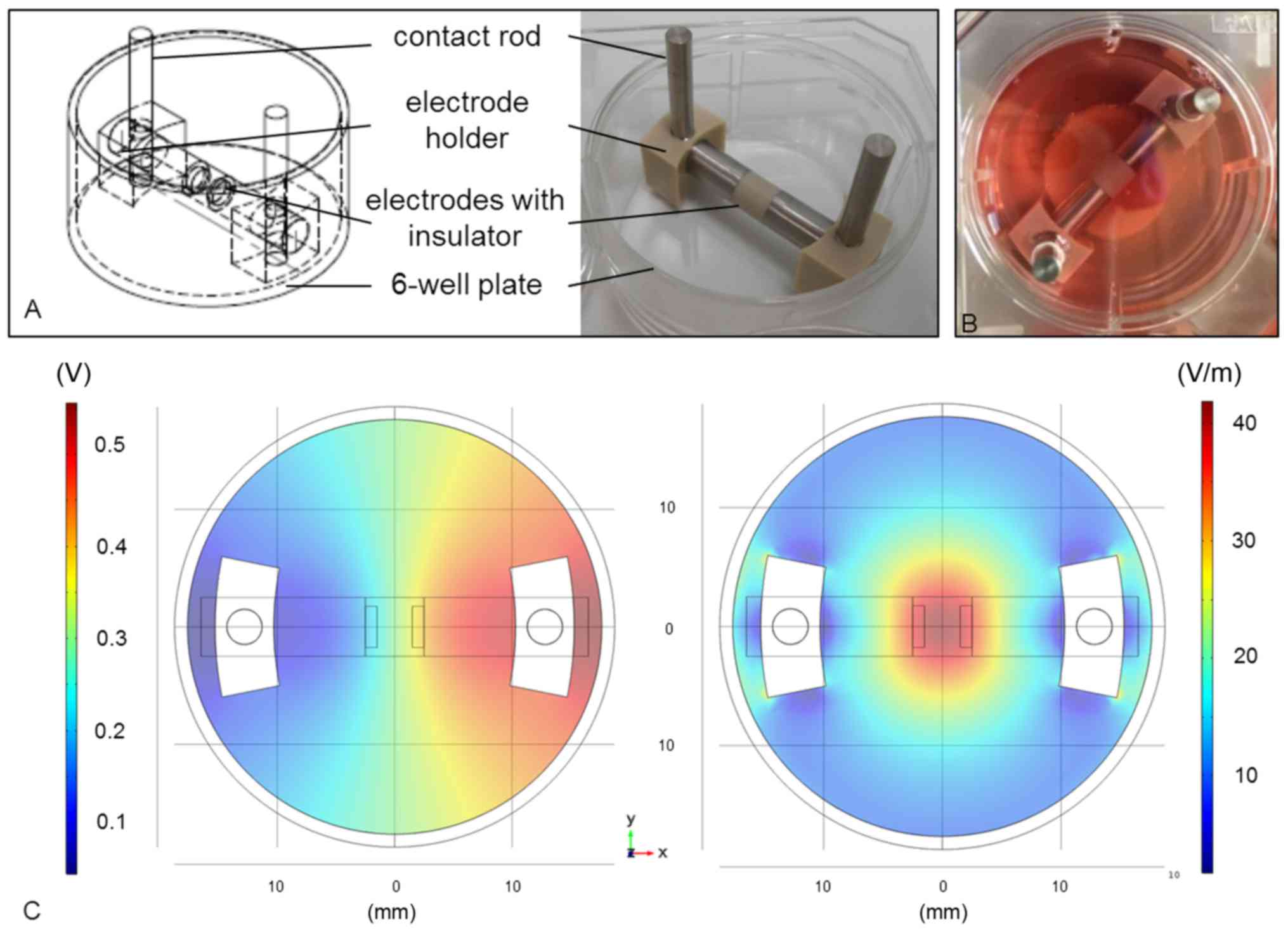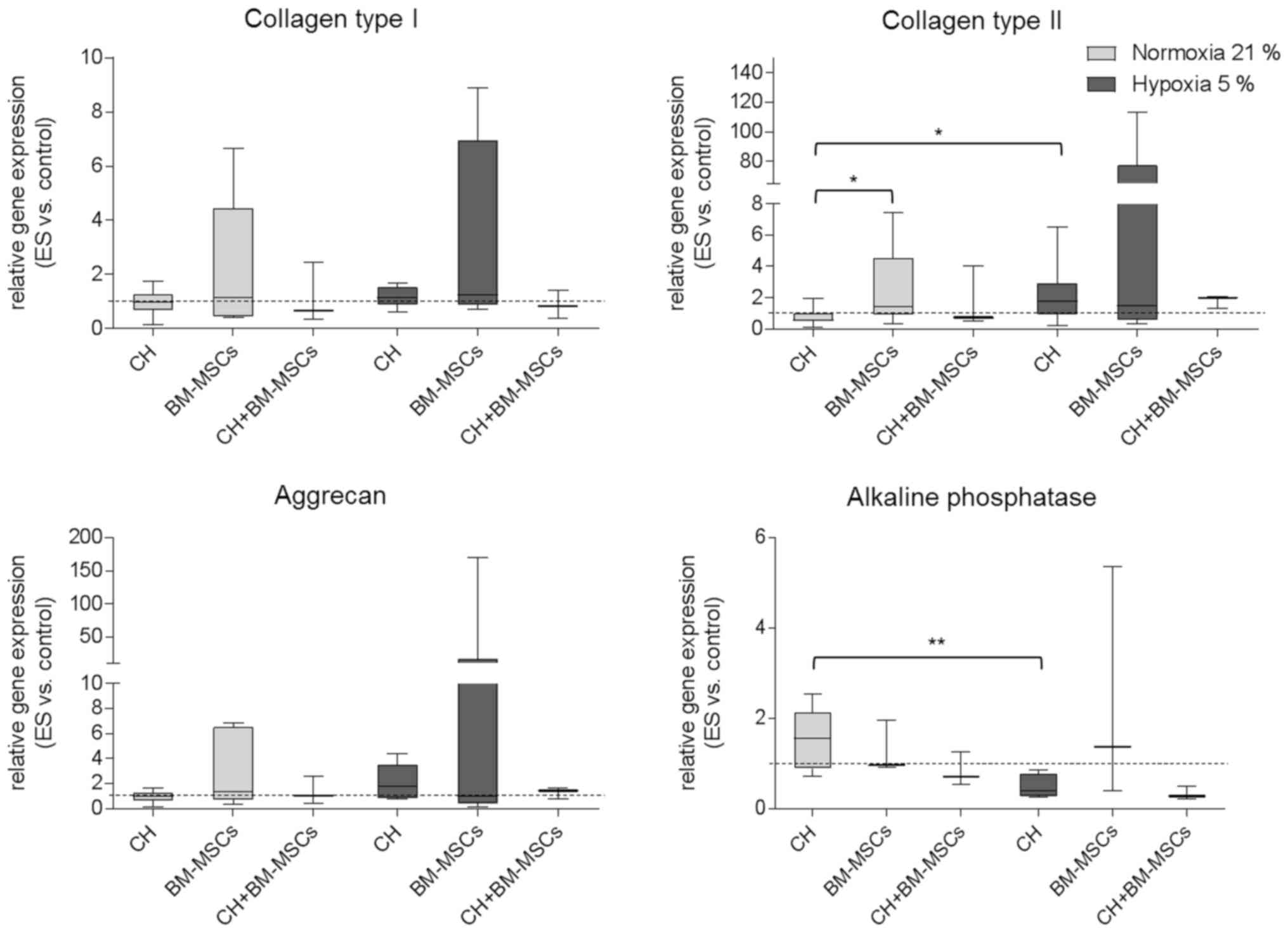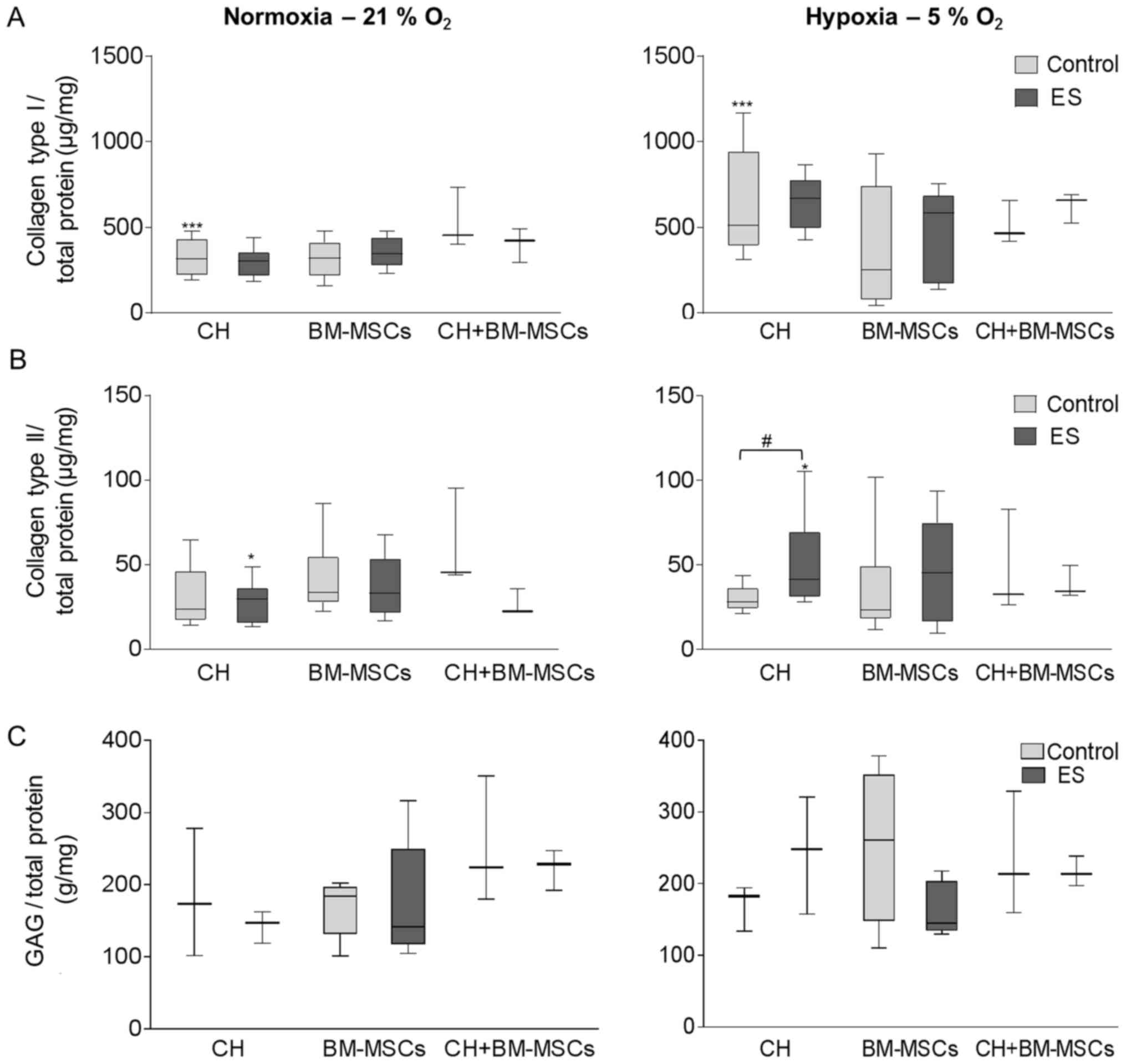|
1
|
Jahr H, Matta C and Mobasheri A:
Physicochemical and biomechanical stimuli in cell-based articular
cartilage repair. Curr Rheumatol Rep. 17:222015. View Article : Google Scholar : PubMed/NCBI
|
|
2
|
Rudert M and Wirth CJ: Knorpelregeneration
und KnorpelersatzKompendium der praktischen Medizin.
Springer-Verlag; Berlin Heidelberg: pp. 1205–1218. 2000, View Article : Google Scholar
|
|
3
|
Brady MA, Waldman SD and Ethier CR: The
application of multiple biophysical cues to engineer functional
neocartilage for treatment of osteoarthritis. Part II: Signal
transduction. Tissue Eng Part B Rev. 21:20–33. 2015. View Article : Google Scholar : PubMed/NCBI
|
|
4
|
Bernhard JC and Vunjak-Novakovic G: Should
we use cells, biomaterials, or tissue engineering for cartilage
regeneration? Stem Cell Res Ther. 7:562016. View Article : Google Scholar : PubMed/NCBI
|
|
5
|
Welsch GH, Mamisch TC, Zak L, Blanke M,
Olk A, Marlovits S and Trattnig S: Evaluation of cartilage repair
tissue after matrix-associated autologous chondrocyte
transplantation using a hyaluronic-based or a collagen-based
scaffold with morphological MOCART scoring and biochemical T2
mapping: Preliminary results. Am J Sports Med. 38:934–942. 2010.
View Article : Google Scholar : PubMed/NCBI
|
|
6
|
Pasold J, Zander K, Heskamp B, Grüttner C,
Lüthen F, Tischer T, Jonitz-Heincke A and Bader R: Positive impact
of IGF-1-coupled nanoparticles on the differentiation potential of
human chondrocytes cultured on collagen scaffolds. Int J
Nanomedicine. 10:1131–1143. 2015. View Article : Google Scholar : PubMed/NCBI
|
|
7
|
Farrell E, O'Brien FJ, Doyle P, Fischer J,
Yannas I, Harley BA, O'Connell B, Prendergast PJ and Campbell VA: A
collagen-glycosaminoglycan scaffold supports adult rat mesenchymal
stem cell differentiation along osteogenic and chondrogenic routes.
Tissue Eng. 12:459–468. 2006. View Article : Google Scholar : PubMed/NCBI
|
|
8
|
Caldwell KL and Wang J: Cell-based
articular cartilage repair: The link between development and
regeneration. Osteoarthritis Cartilage. 23:351–362. 2015.
View Article : Google Scholar : PubMed/NCBI
|
|
9
|
Steinert AF, Ghivizzani SC, Rethwilm A,
Tuan RS, Evans CH and Nöth U: Major biological obstacles for
persistent cell-based regeneration of articular cartilage.
Arthritis Res Ther. 9:2132007. View
Article : Google Scholar : PubMed/NCBI
|
|
10
|
Ko CK, Lee EY, Jang JD, Kim SJ, Suh DS and
Chang CH: Cartilage regeneration using a fibrin and autologous
cultured chondrocytes mixture in a canine model. J Tissue Sci Eng.
3:1142012. View Article : Google Scholar
|
|
11
|
Nukavarapu SP and Dorcemus DL:
Osteochondral tissue engineering: Current strategies and
challenges. Biotechnol Adv. 31:706–721. 2013. View Article : Google Scholar : PubMed/NCBI
|
|
12
|
Pittenger MF, Mackay AM, Beck SC, Jaiswal
RK, Douglas R, Mosca JD, Moorman MA, Simonetti DW, Craig S and
Marshak DR: Multilineage potential of adult human mesenchymal stem
cells. Science. 284:143–147. 1999. View Article : Google Scholar : PubMed/NCBI
|
|
13
|
Huang BJ, Hu JC and Athanasiou KA:
Cell-based tissue engineering strategies used in the clinical
repair of articular cartilage. Biomaterials. 98:1–22. 2016.
View Article : Google Scholar : PubMed/NCBI
|
|
14
|
Madeira C, Santhagunam A, Salgueiro JB and
Cabral J: Advanced cell therapies for articular cartilage
regeneration. Trends Biotechnol. 33:35–42. 2015. View Article : Google Scholar : PubMed/NCBI
|
|
15
|
Liu X, Sun H, Yan D, Zhang L, Lv X, Liu T,
Zhang W, Liu W, Cao Y and Zhou G: In vivo ectopic chondrogenesis of
BMSCs directed by mature chondrocytes. Biomaterials. 31:9406–9414.
2010. View Article : Google Scholar : PubMed/NCBI
|
|
16
|
Meretoja VV, Dahlin RL, Kasper FK and
Mikos AG: Enhanced chondrogenesis in co-cultures with articular
chondrocytes and mesenchymal stem cells. Biomaterials.
33:6362–6369. 2012. View Article : Google Scholar : PubMed/NCBI
|
|
17
|
Levorson EJ, Santoro M, Kasper FK and
Mikos AG: Direct and indirect co-culture of chondrocytes and
mesenchymal stem cells for the generation of polymer/extracellular
matrix hybrid constructs. Acta Biomater. 10:1824–1835. 2014.
View Article : Google Scholar : PubMed/NCBI
|
|
18
|
Heng BC, Cao T and Lee EH: Directing stem
cell differentiation into the chondrogenic lineage in vitro. Stem
Cells. 22:1152–1167. 2004. View Article : Google Scholar : PubMed/NCBI
|
|
19
|
Xu J, Wang W, Clark CC and Brighton CT:
Signal transduction in electrically stimulated articular
chondrocytes involves translocation of extracellular calcium
through voltage-gated channels. Osteoarthritis Cartilage.
17:397–405. 2009. View Article : Google Scholar : PubMed/NCBI
|
|
20
|
Wang W, Wang Z, Zhang G, Clark CC and
Brighton CT: Up-regulation of chondrocyte matrix genes and products
by electric fields. Clin Orthop Relat Res. 427 Suppl:S163–S173.
2004. View Article : Google Scholar : PubMed/NCBI
|
|
21
|
Brighton CT, Wang W and Clark CC: The
effect of electrical fields on gene and protein expression in human
osteoarthritic cartilage explants. J Bone Joint Surg Am.
90:833–848. 2008. View Article : Google Scholar : PubMed/NCBI
|
|
22
|
Vavken P, Arrich F, Schuhfried O and
Dorotka R: Effectiveness of pulsed electromagnetic field therapy in
the management of osteoarthritis of the knee: A meta-analysis of
randomized controlled trials. J Rehabil Med. 41:406–411. 2009.
View Article : Google Scholar : PubMed/NCBI
|
|
23
|
Fioravanti A, Nerucci F, Collodel G,
Markoll R and Marcolongo R: Biochemical and morphological study of
human articular chondrocytes cultivated in the presence of pulsed
signal therapy. Ann Rheum Dis. 61:1032–1033. 2002. View Article : Google Scholar : PubMed/NCBI
|
|
24
|
Ongaro A, Pellati A, Masieri FF, Caruso A,
Setti S, Cadossi R, Biscione R, Massari L, Fini M and De Mattei M:
Chondroprotective effects of pulsed electromagnetic fields on human
cartilage explants. Bioelectromagnetics. 32:543–551. 2011.
View Article : Google Scholar : PubMed/NCBI
|
|
25
|
Hiemer B, Ziebart J, Jonitz-Heincke A,
Grunert PC, Su Y, Hansmann D and Bader R: Magnetically induced
electrostimulation of human osteoblasts results in enhanced cell
viability and osteogenic differentiation. Int J Mol Med. 38:57–64.
2016. View Article : Google Scholar : PubMed/NCBI
|
|
26
|
Dauben TJ, Ziebart J, Bender T, Zaatreh S,
Kreikemeyer B and Bader R: A novel in vitro system for comparative
analyses of bone cells and bacteria under electrical stimulation.
Biomed Res Int. 2016:51786402016. View Article : Google Scholar : PubMed/NCBI
|
|
27
|
Jonitz A, Lochner K, Peters K, Salamon A,
Pasold J, Mueller-Hilke B, Hansmann D and Bader R: Differentiation
capacity of human chondrocytes embedded in alginate matrix. Connect
Tissue Res. 52:503–511. 2011. View Article : Google Scholar : PubMed/NCBI
|
|
28
|
Jonitz-Heincke A, Klinder A, Boy D,
Salamon A, Hansmann D, Pasold J, Buettner A and Bader R: In vitro
analysis of the differentiation capacity of postmortally isolated
human chondrocytes influenced by different growth factors and
oxygen levels. Cartilage: 1947603517719318. 2017. View Article : Google Scholar
|
|
29
|
Bentivegna A, Roversi G, Riva G, Paoletta
L, Redaelli S, Miloso M, Tredici G and Dalprà L: The effect of
culture on human bone marrow mesenchymal stem cells: Focus on DNA
methylation profiles. Stem Cells Int. 2016:56567012016. View Article : Google Scholar : PubMed/NCBI
|
|
30
|
Chua KH, Aminuddin BS, Fuzina NH and
Ruszymah BH: Insulin-transferrin-selenium prevent human chondrocyte
dedifferentiation and promote the formation of high quality tissue
engineered human hyaline cartilage. Eur Cell Mater. 9:58–67. 2005.
View Article : Google Scholar : PubMed/NCBI
|
|
31
|
Jonitz A, Lochner K, Tischer T, Hansmann D
and Bader R: TGF-β1 and IGF-1 influence the re-differentiation
capacity of human chondrocytes in 3D pellet cultures in relation to
different oxygen concentrations. Int J Mol Med. 30:666–672. 2012.
View Article : Google Scholar : PubMed/NCBI
|
|
32
|
Peterkofsky B: Bacterial collagenase
methods in enzymology. 82:453–471. 1982. View Article : Google Scholar
|
|
33
|
Livak KJ and Schmittgen TD: Analysis of
relative gene expression data using real-time quantitative PCR and
the 2(-Delta Delta C(T)) method. Methods. 25:402–408. 2001.
View Article : Google Scholar : PubMed/NCBI
|
|
34
|
Saggese G, Bertelloni S, Baroncelli GI and
Di Nero G: Serum levels of carboxyterminal propeptide of type I
procollagen in healthy children from 1st year of life to adulthood
and in metabolic bone diseases. Eur J Pediatr. 151:764–768. 1992.
View Article : Google Scholar : PubMed/NCBI
|
|
35
|
Parfitt AM, Simon LS, Villanueva AR and
Krane SM: Procollagen type I carboxy-terminal extension peptide in
serum as a marker of collagen biosynthesis in bone. Correlation
with Iliac bone formation rates and comparison with total alkaline
phosphatase. J Bone Miner Res. 2:427–436. 1987. View Article : Google Scholar : PubMed/NCBI
|
|
36
|
Vaca-González JJ, Guevara JM, Vega JF and
Garzón-Alvarado DA: An in vitro chondrocyte electrical stimulation
framework: A methodology to calculate electric fields and modulate
proliferation, cell death and glycosaminoglycan synthesis. Cel Mol
Bioeng. 9:116–126. 2016. View Article : Google Scholar
|
|
37
|
Windisch C, Kolb W, Röhner E, Wagner M,
Roth A, Matziolis G and Wagner A: Invasive electromagnetic field
treatment in osteonecrosis of the femoral head: A prospective
cohort study. Open Orthop J. 8:125–129. 2014. View Article : Google Scholar : PubMed/NCBI
|
|
38
|
Vinatier C, Mrugala D, Jorgensen C,
Guicheux J and Noël D: Cartilage engineering: A crucial combination
of cells, biomaterials and biofactors. Trends Biotechnol.
27:307–314. 2009. View Article : Google Scholar : PubMed/NCBI
|
|
39
|
Chen S, Fu P, Cong R, Wu H and Pei M:
Strategies to minimize hypertrophy in cartilage engineering and
regeneration. Genes Dis. 2:76–95. 2015. View Article : Google Scholar : PubMed/NCBI
|
|
40
|
Lefebvre V and Smits P: Transcriptional
control of chondrocyte fate and differentiation. Birth Defects Res
C Embryo Today. 75:200–212. 2005. View Article : Google Scholar : PubMed/NCBI
|
|
41
|
Sliogeryte K, Botto L, Lee DA and Knight
MM: Chondrocyte dedifferentiation increases cell stiffness by
strengthening membrane-actin adhesion. Osteoarthritis Cartilage.
24:912–920. 2016. View Article : Google Scholar : PubMed/NCBI
|
|
42
|
Haleem AM and Chu CR: Advances in tissue
engineering techniques for articular cartilage repair. Oper Tech
Orthop. 20:76–89. 2010. View Article : Google Scholar : PubMed/NCBI
|
|
43
|
Mayer-Wagner S, Passberger A, Sievers B,
Aigner J, Summer B, Schiergens TS, Jansson V and Müller PE: Effects
of low frequency electromagnetic fields on the chondrogenic
differentiation of human mesenchymal stem cells.
Bioelectromagnetics. 32:283–290. 2011. View Article : Google Scholar : PubMed/NCBI
|
|
44
|
Kwon HJ, Lee GS and Chun H: Electrical
stimulation drives chondrogenesis of mesenchymal stem cells in the
absence of exogenous growth factors. Sci Rep. 6:393022016.
View Article : Google Scholar : PubMed/NCBI
|
|
45
|
Yoon HH, Bhang SH, Shin JY, Shin J and Kim
BS: Enhanced cartilage formation via three-dimensional cell
engineering of human adipose-derived stem cells. Tissue Eng Part A.
18:1949–1956. 2012. View Article : Google Scholar : PubMed/NCBI
|
|
46
|
Nydegger UE: Progress in complement
research: 1984. Year Immunol. 171–174. 1985.PubMed/NCBI
|
|
47
|
Chen FH, Rousche KT and Tuan RS:
Technology insight: Adult stem cells in cartilage regeneration and
tissue engineering. Nat Clin Pract Rheumatol. 2:373–382. 2006.
View Article : Google Scholar : PubMed/NCBI
|













